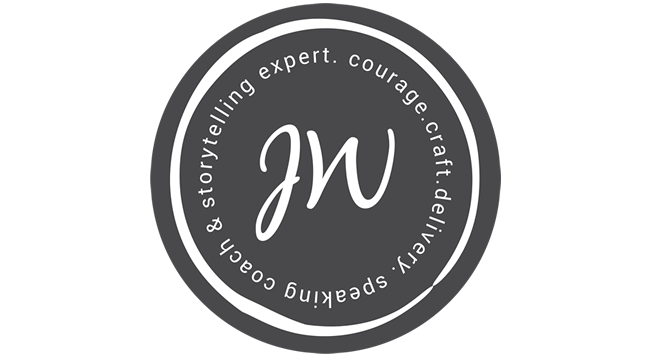How Storytelling Can Change Lives and Influence Audiences: The Importance of Stories in Business and Leadership
February 8th, 2022

You’ve heard it before: Storytelling is one of the oldest forms of communication. It’s been used to teach, entertain, and influence people for centuries. And it’s still working its magic in the business world. Storytelling is a powerful tool for entrepreneurs and leaders. It will not only help you connect with your audience, it has the potential to change lives.
Before I started my speaking & coaching business, I was an actor for CIT trainings for police officers. They were learning skills for dealing with people with mental illness in crisis. The goal was to teach them to offer resources rather than “go tactical.”
I would play the part of a person with a mental illness in a crisis situation (the situations all came from real 911 calls…and you wouldn’t believe some of the situations). If the officer was using his or her skills well, I complied. If not, I escalated the crisis.
One day when my job was to play an officer who was facing depression, and who hadn’t shown up for work in several days. My character was contemplating suicide. The cops in training were doing a welfare check.
Each officer went through the scenario, and in most cases, I stayed depressed. I met the officers with a “yeah whatever” attitude. They did fine, but my character still might have taken steps to end her life once they walked out the door.
But one was different.
He sat down next to me, looked into my eyes and said “I get it. I’ve been there too.”
Then he told me a story.
For a moment I even fell out of my character and became rapt listening to this deeply compelling and vulnerable account of his own depression, and how he took a risk to trust someone who wanted to help him find his way out of it.
Back in character, I agreed to go with him to get help. I didn’t kill myself.
Afterwards I approached him to let him know he’d done a great job, and to tell him how deeply his story impacted me. We chatted for a bit, and he told me he had indeed saved lives on the street by sharing his own story.
I tell this story because as speakers we are all salespeople. We’re all saving lives. Or changing them at least. When you speak, you’re asking your audience to trade an old way of thinking for a new way of thinking.
Let’s look at how storytelling relates to business and leadership
Whether you’re selling a service, an idea, a new behavior, a shift in perspective, you want your audience to say yes, right? Just like that cop was selling the idea that help was out there for my character, and it might be worth it to go after it, we as speakers are selling ideas to our audiences so they can live the life they want.
In a world where most of us are struggling with information overload and a business landscape that changes exponentially on a daily basis, storytelling gives you the power to cut through the noise, make meaningful connections, inspire and influence as a leader in your industry.
Whether you’re a solopreneur in a service industry, a CEO at a fortune 500, or a seasoned serial entrepreneur with multiple brands, storytelling is a “must” tool to have in your marketing and leadership tool belts.
“You can have the best technology, you can have the best business model, but if the storytelling isn’t amazing, it won’t matter. Nobody will watch.” ~ Jeff Bezos
Since you’re the only one who can tell your story, or your company’s story, the story is what will set you apart as a leader. It will allow you to show your audience what’s possible, motivate them to want more, and move them to action. Not only will storytelling help you inspire and influence your audience, it will make you stand out as a brand. Period.
Check out these brands that use stories in a way that allows customers to make emotional connections with the story, and then connect to their own vision of what’s possible.
I love this hilarious and heartwarming VW ad about this kid’s Darth Vader power.
And this Bell’s ad about the dad who learned to read so he could read his son’s book. It chokes me up every time.
Or this Nike campaign about the greatness in all of us.
And of course the epic Budweiser ads. Oh my this one is a tearjerker for sure.
Stories invite people to connect emotionally. When you’re connected emotionally to your customers, you build loyalty. Your people trust you. They’re like Flynn. They want more.
Your prospective clients and customers don’t want to hear “how amazing your services or products are”, they want to hear the story of how you climbed the mountain with a broken leg and one crutch, because then they’ll be able to see that they can climb that mountain too.
They want to hear how you faced your debilitating fear of picking up the phone, and because of that one scary phone call you started the non-profit that now serves millions.
Wait what? You don’t have a big story of overcoming adversity? That’s ok.
They also want to hear the small stories of how you finally ran a mile when last week you could barely make it to the corner.
And how you got your kid to sit down at dinner with you and tell you about his day.
Great storytelling requires vision, creativity, skill, strategy and practice. Stick around while I do a deep dive into Storytelling, in this article and the ones to follow. I’ll talk about what it is and isn’t, why you need it to stand out as a business leader and just how to craft a story that wins your audience’s hearts and minds.
First, let’s be clear on what good storytelling isn’t…
It’s not simply recounting events in chronological order.
It’s not a deep dive into the tragedies and traumas of your childhood.
It’s not a showcase of all your amazing achievements.
It’s not a quagmire of details and weed patches that lead you to nowhere.
What makes a good story?
In my last blog I shared my top 7 competencies to becoming a powerful speaker. Want to take a guess on #5? Yep. Tell a better story. Here’s how:
A good story is an emotional journey that arrives at an epiphany, an aha moment. Something changes. You, the protagonist, are different at the end than you were at the beginning. No matter how benign the change, something changes.
A good story conveys the message you want to deliver. It’s a straight shot to the heart. It doesn’t have to take a side trip to the brain to make the connection. It’s human to human, heart to heart, me to you.
I say, “Here’s what I’ve figured out about being human.”
You say, “Ohhhh. I understand. I’m like you. I like you. I want to hear more.”
A good story conveys the ideas you want to communicate to your audience by taking them on a journey with you.
A good story makes me feel like your story is happening to me as the story unfolds.
When I walk out of the movie and Harry Potter just saved the day, I feel like I saved the day too. I was on that journey with him. Not only has he changed, but I am changed.
When you as a speaker tell a good story, you invite your audience into a transformation. Into deeper connection with you. They feel changed by your story.
When it comes to business, leadership and influencing people to take an action, your story is what will inspire and motivate and eventually guide your audiences to make a decision to act.
A good story helps simplify complex information and gives you a competitive advantage in the market. It’s about strategically using facts and emotions in a way that shows your audience what’s possible.
So yeah, storytelling is an old art form that’s been used in every culture and society since the dawn of time. We as humans are hardwired to tell and respond to stories.
But here’s the thing: While everyone can tell a story, and does tell stories even when they’re not aware of it, a lot of people still s**k at telling stories!
Here are some of the ways they fall flat:
1. You don’t understand what TYPE of story is needed, so you tell the wrong story at the wrong time.
2. You have no clue WHY you’re telling the story (“You told me to tell stories, so I told stories!”) and no idea how to relate your story to your audience.
3. You don’t really understand how to CRAFT a story, so you get lost on side roads, or skip over important details, or give way too many details. You don’t build adequate stakes, and your story falls flat.
4. Your DELIVERY of the story doesn’t bring it to life. Which means you aren’t using your voice and body effectively. Or you report on the thing that happened a long time ago rather than bring me into the heart of it.
Let’s start with #1. When you’re gathering stories, it’s important to understand just why you’re telling them, and how they fit into the bigger picture. Here are the 3 types of stories you need to have in your pocket as a speaker and a business owner.
As you build your treasure chest of stories, point your mind in these categories:
1. YOUR WHY STORY
This is the story of why you do what you do, and one of the most important stories you can tell.
What’s the idea that is the heartbeat of your work?
What keeps you ticking in spite of all the challenges?
It’s the purpose of your company. The reason your work matters.
When I work with clients in the Craft Your Talk program, the first thing we do is articulate the Genie Gem. This is your gem of genius that is the north star of your talk. You’ve got an idea. Some nuggets of wisdom. A perspective that drives your work. That’s your Genie Gem.
Once we articulate that I ask “How do you know that’s true?” Or “When did you first discover this?” Or “What happened that pointed you to this idea?”
That’s your story. You’re inviting your audience to go on a journey with you. Which means you’ve got to walk them on the journey you took to get to that Big Idea you’re asking them to say yes to.
There’s a good chance it’s not a story that appears on the surface to be directly connected to your company. It could come from childhood, or a job you used to have, or something that happened one strange winter night that reminded you what matters.
My cop story is a kind of why story. It shows you storytelling in action, and clearly communicates the power of storytelling. . That cop kept me (my character) from (theoretically) killing herself because he told a story.
Storytelling has the power to save lives. Boom. That’s why I do what I do.
2. YOUR INCEPTION STORY
This is the story of how you started doing the work you do. My guess is that once upon a time, you had a big problem (likely the same problem your clients have today)… You searched, did your fair share of trial and error until one day, you had a big “AHA” and you figured out how to solve your big problem and reach your goals.
Or more likely the big AHA didn’t come in one lightbulb moment, but instead in a whole bunch of little aha’s that developed over time into a Big Idea.
I had years of experience on stage as a theater artist, but “public speaking” was something that happened far away in a world that was not my hippie artist world. When one of my solo-performance students asked me to coach her for her upcoming TEDx talk, I said “Sure, I’ll see what I can do.”
At that moment I had no idea what door that would open for me.
But indeed it opened a door to coaching others. I hired a business coach and before long I had a business. When he said “Now Johanna you have to go find a stage to speak on,” I laughed and said NO WAY! I can help people speak, but I’m not a speaker myself. I have nothing to say!”
Maybe you can guess what my coach said to me.
That’s the day my business began.
I tell that story to show my audiences that I get it. I get how scary it can be to decide you have something to say, and then to say it. And how powerful it is when you say it anyway.
So back to you: You started your business to help others solve the problem you now have the solution to. Am I right?
That is your inception story!
How did you reach that “AHA”? What did you go through, what result did you have? How did it feel to go from that “hell of a problem” to that “heavenly solution”?
3. YOUR STUNNING RESULTS STORIES
Your Stunning Results story is the story of how you help your clients get more of what they want. More money, more time, more health or more happiness!
What is your value proposition? How do you help people? What problems do you solve and what desires do you fulfill? How does your company or product make a difference in people’s lives?
It’s one of the most important stories you can tell. This story is actually best told by a customer herself. But whether you tell it or someone else tells it, it’s one you’ve got to have in your arsenal.
When you can articulate the difference you make, it’s easier for people to understand why they should care about what you do and why they should work with you.
To recap, stories can make you relatable, interesting and trustworthy. They have the power to shape people’s lives.
Now that you’re clear about the TYPES of stories you need to have in your treasure chest, stay tuned for the next couple of articles when we dig into how to CRAFT and DELIVER your stories.
Stories give your brand storyteller (you) access into customers’ hearts by showing “real-life” benefits of services or products that will engage potential buyers on an emotional level. Master the skills you need to tell a compelling story that will make your audience want to follow you, hire you and tell their friends about you.
« Powerful Speaking Skills That Will Make Your Talks Monumentally Successful | Skinny Dipping with Johanna — how it started »


 FACEBOOK
FACEBOOK INSTAGRAM
INSTAGRAM LINKEDIN
LINKEDIN SUBSCRIBE
SUBSCRIBE
Leave a Reply